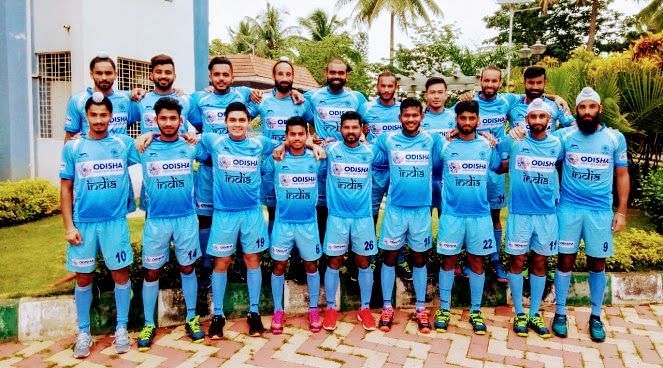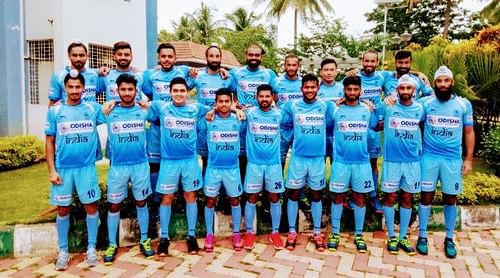
FIH Champions Trophy: Why PC conversion will be vital as India look to better 50% win record

The first half of a crowded and prestigious calendar year of hockey has witnessed a fair share of action, drama, and tumult on and off the pitch. A Four-Nation Invitational in New Zealand served as a preparatory kick-start to the year, following which India's young team of the future made their mark in Ipoh at the Azlan Shah Cup.
Nothing seemed to be seriously amiss, as India headed to Gold Coast powered by a balanced squad of eighteen members who, on paper at least, had the prowess to defend India's silver-medal winning performance of 2010 and 2014. True, India had failed to match their silver-medal winning performance in Ipoh as well, but the clamor was stifled by a remarkable show from a young team of rookies.
The alarm bells rang out loud and clear, as a full-strength Indian squad looked out of sorts and failed to live up to their ominous reputation at the Commonwealth Games. With the three most vital tournaments of the season lined up ahead, Hockey India decided to take action with a change of mentor at the helm.
Both coaches concur that not a lot was wrong
"Expectations were very high, but I could see the circle penetrations and the shots on goal were there too. There was a thin line (between the winner and the loser.) The score on the board was missing," said coach Harendra Singh, on summing up the team's performance at the Commonwealth Games.
Interestingly, former coach Sjoerd Marijne too told us after India's semifinal loss to New Zealand that the team had created enough. India enjoyed 52 percent of the possession and managed 32 circle penetrations, 9 shots on goal and 9 PCs, but inexplicably ended up on the losing side against the Black Sticks.
What then is the solution, we asked Harendra Singh, if the Indian players are able to enter the opposition circle time and again, but unable to score?
Getting it right in the striking circle
"I think every player should understand, especially the strikers, that you have a split second to take a decision. You can take the right decision when you are in the position.to either pass the ball or take the shot at goal." The coach emphasized the fact that the body needs to be at an angle of 45 degrees to be effective in the circle, and taking a shot was not necessary each time, he said, as the players could use their wrists to good effect.
Mandeep's goal against England in the CWG, he said, was an example of how one can deflect the ball into the goal without stopping it or passing.
Twelve months ago, Akashdeep Singh displayed how sublime use of the wrists can be much more potent that hard shots.
Against the Netherlands, in an HWL Semi-Final encounter, the electrifying striker made a sizzling run towards the goalmouth and latched on to a brilliant cross from Ramandeep Singh from the right flank. He then used his wrists to nudge the ball deftly between the legs of the Dutch keeper to score a spectacular goal which became the talking point of the match in spite of India's loss.
Ramandeep's assists, such as the one above, has proven invaluable for India as they did recently at the Sultan Azlan Shah Cup, where the Indian striker's magical pass enabled debutante Shilanand Lakra to score against England. Ramandeep was instrumental against the Aussies at Ipoh where he scored a brace and his return to the squad will bolster India's options up front.
SV Sunil was the livewire for India at Gold Coast and the speedy veteran from Coorg will need to carry his good form forward as well.
The redoubtable Indian forward line failed to find their magic touch at Gold Coast, but have displayed their unmistakable talent on the world stage in the past and will look to recapture the winning touch at Breda.
PCs vital in modern hockey

When asked how the Indians were aiming for a podium finish after a couple of indifferent outings, Indian coach Harendra Singh cited the example of Argentina defying the odds to win an Olympic gold. Argentina is a vital case in point indeed, but how did the South Americans achieve glory in Brazil?
Gonzalo Peillat found the mark 11 times in Rio 2016 to power his team to a victory with his powerful drag flicks and was the leading scorer of the tournament.
India's Analytical Coach, Chris Ciriello, the master of PC hattricks in big finals scored thrice to deny India gold in the CWG at Glasgow and did the same against the Dutch, as Australia thrashed the Netherlands 6-1 in their own backyard to win the World Cup in 2014.
How vital are PCs for India?
"A team which can convert 28 to 32 percent of their penalty corners are in the bracket of a podium finish," said coach Harendra Singh. He added that once a drag-flicker becomes lethal, he then is on the radar of coaches worldwide and also that India needs to develop a mix of direct flicks and indirect variations to play on the mindset of the opposition and cited the Germans as a prime example.
The statistics for the last six months tell us that India converted 28 of their 96 PCs with a conversion rate of just over 29%. India incidentally is the only country which boasts of a four-man penalty corner battery.
At Gold Coast, India gained 39 PCs and converted only 11. In spite of the low percentage of conversion, a closer look at the numbers reveals the significance of the goals scored from drag flicks.
India managed to score just 4 field goals out of a total of 15 in the entire tournament. Dilpreet Singh scored a couple of them, one against Pakistan and another against Wales. Manpreet scored one against England as did Mandeep with his brilliant deflection in the pool match.
All the other goals were scored from drag flicks or from deflections following the flicks. It goes without saying that the Indians are heavily dependent on penalty corners to score and have no option but to get them right. In stark contrast, the Aussies scored a total of 20 goals during the CWG, of which 15 were field goals and just 5 resulted from PCs!
Harmanpreet Singh did his bit at Gold Coast and in the absence of Rupinder will have to shoulder a lot of the responsibility at Breda as well.
A look at the statistics of the Azlan Shah tournament also is vital as Amit Rohidas and Varun Kumar donned the role of drag-flickers at Ipoh just as they will at Breda.
Amit Rohidas scored twice in the Azlan Shah Cup against Argentina and a third against Ireland in the pool match while Varun Kumar scored twice at Ipoh in the classification match against Ireland.
Fifty percent win record, but all is not lost
The Indians have played 20 matches spread over the course of the three tournaments thus far, winning 10 of them and have lost 7.
The team had a fantastic start to the year when they beat Belgium 5-4 in a thriller in New Zealand and also beat the hosts, and Japan. Young Vivek Sagar Prasad was the find of the tournament for India and displayed his unmistakable brilliance.
In Ipoh, Gonzalo Peillat showed his class with a PC hattrick in the opening match of the Azlan Shah Cup, but Amit Rohidas showed his prowess in the same department as India lost narrowly by a 2-3 margin to the Olympic champions. India drew with England and fought valiantly before going down 2-4 to world champions Australia.
A positive at Gold Coast was that India defended PCs quite well, in spite of conceding too many. India conceded 31 PCs but ensured that only 9 of them resulted in goals.
India did just about everything right with regard to their attacks at Gold Coast but was unable to score, and if coach Harendra Singh is able to sort these flaws, along with plugging gaps in the defense, and ensuring that the boys concede fewer PCs, Sreejesh, and his team could surprise many and stand atop the podium at Breda.